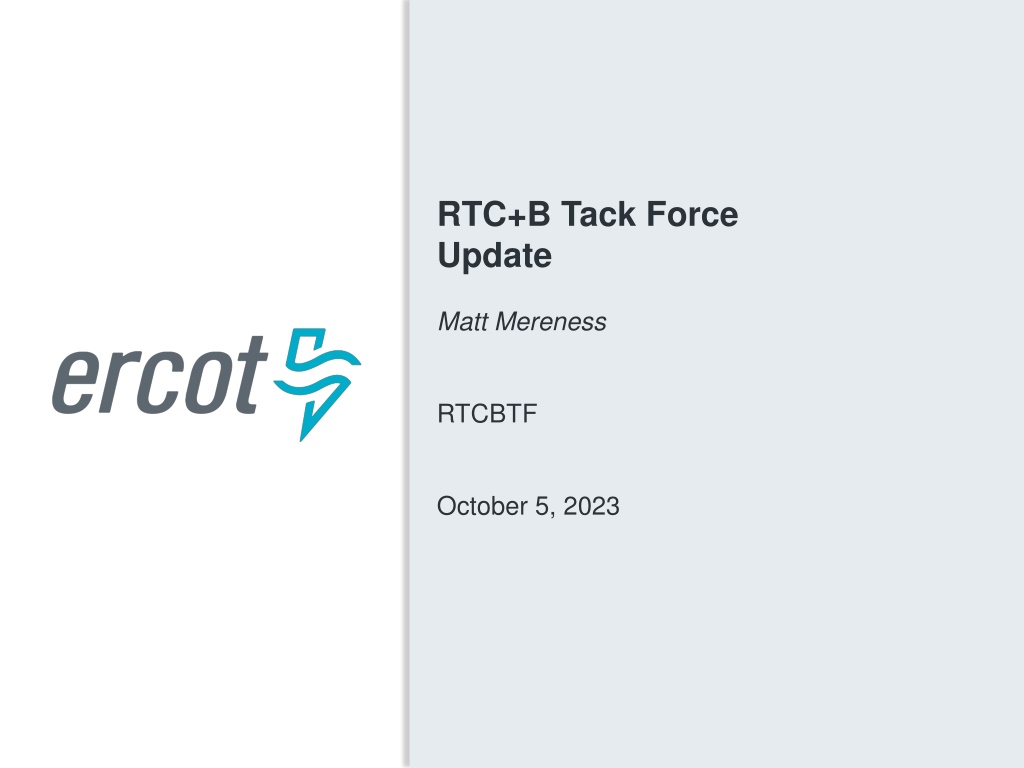ERCOT RTC+B Program Review Updates
ERCOT provides updates on the RTC+B Tack Force for the Real-Time Co-Optimization Program. The updates include leadership confirmations, meeting schedules, deadlines, and details on the program scope and charter review. The program aims to implement real-time co-optimization with batteries included, managing risks and ensuring successful implementation. Stakeholders collaborate to coordinate activities, mitigate risks, and support the program's progress until stabilization.
Download Presentation

Please find below an Image/Link to download the presentation.
The content on the website is provided AS IS for your information and personal use only. It may not be sold, licensed, or shared on other websites without obtaining consent from the author. Download presentation by click this link. If you encounter any issues during the download, it is possible that the publisher has removed the file from their server.
E N D
Presentation Transcript
RTC+B Tack Force Update Matt Mereness RTCBTF October 5, 2023
RTCBTF Update TAC confirmed leadership for RTCBTF Chair: Matt Mereness (ERCOT) Vice-Chair: David Kee (CPS Energy) TAC awareness of deadline for RTC-SOC NPRR : Sequence of seven meetings Sept-Dec Sep 8- Initial review of RTC-SOC whitepaper with RTCBTF ERCOT release of draft NPRR language estimated for Sep 22 (sent Sep 27) Comments to whitepaper and/or draft NPRR due Sep 27 (1 set of comments received Oct 2) Oct 5- RTCBTF review of feedback on whitepaper and/or NPRR language Oct 11 - Target release of formal NPRR for RTC-SOC Oct 12- PRS initial review and seek urgency for RTC-SOC NPRR Nov 1- RTCBTF review to discuss/reconcile any issues Nov 9- PRS approval Dec 4- TAC approval Dec 19- Board approval Today s RTCBTF meeting is dedicated to focus on RTC-SOC 2 Public
Appendix - Scope of RTC+B Program - Review of RTCBTF Charter - Plans for Meetings and Review Cycles - Types of Work and Scheduling 3 3 Public
Scope of RTC+B Program ERCOT has re-started the Program and sub-projects needed to implement Real-Time Co-optimization The scope the Program is limited to: RTC (NPRR1007-1013) Single Model Batteries (NPRR1014) RTC State of Charge modeling in SCED and RUC (NPRR forthcoming) Internally ERCOT refers to the program as RTC+B (batteries included with RTC) Current estimated cost and timeline is $50M with target delivery in 2026 ERCOT also recognizes the potential challenges and constraints with other efforts, but is committed to continuing forward progress on the RTC+B program. 4 Public
Review of RTCBTF Charter Program Who: Participation in RTCBTF shall consist of ERCOT stakeholders, PUCT Staff, the Independent Market Monitor (IMM), Office of Public Utility Counsel (OPUC), and ERCOT Staff. What/Why: Established to coordinate and review the necessary ERCOT and Market Participant activities to mitigate risk and support the successful implementation of the RTC+B Program. This will include, but is not limited to: Coordinating timelines for interface requirements and testing, Providing the forum for any analysis or policy decisions (such as parameter values) Coordinating market readiness and cutover activities, Review of draft Nodal Protocol Revision Requests (NPRRs) necessary to successfully implement the program within the identified timeframes, and discussing other details as needed. Where: Hybrid meeting (in-person and remote) When: As needed, but primarily monthly, until RTC+B implemented and stabilized 5 Public
Plans for Meetings and Review Cycles Objective is to present concepts or issues that need to be resolved for an effective implementation and drive towards consensus. Lessons learned from RTCTF: Initial concept presented by ERCOT staff Comments and alternatives presented by MPs RTCTF consensus achieved or escalated to TAC for a vote to decide the matter. Plan to continue to the pens-down scope approach RTC Key Principles were approved to lay foundation of NPRR1007-1013 Consolidated Key Principles: https://www.ercot.com/files/docs/2020/04/01/RTC_Key_Principle_Quick_Reference.docx Library of Key Principles: https://www.ercot.com/mktrules/puctDirectives/rtCoOptimization Battery Key Topic Concepts approved to lay foundation of NPRR1014 https://www.ercot.com/mktrules/keypriorities/bes RTC State-of-Charge accounting concept/NPRR to be developed without expanding timeline or costs RTC+B Program beyond current estimates (need December 2023 Board approval). 6 Public
Types of RTCBTF Work and Scheduling Recognition of unfinished RTCTF issues: Parameters for Ancillary Service proxy offers ASDCs for use in Reliability Unit Commitment (RUC) studies Any needed discussion on triggers for initiating off-cycle SCED executions Largely driven by ERCOT Operator desk procedures and discretion today Consideration of NPRR for allowing real-time updates to offers in current Real-Time Market and future with RTC. Framework for periodic analysis comparing RTC and the current ORDC design KP 1.1(8) Verifiable Cost Manual (Change for on-line hydro Resources per Key Principle 1.3(3)) Additional review of transmission constraint max. shadow price values Operation Procedures (e.g., removing SASM and HASL/LASL) Business Practice Manuals (e.g., changes to COP and telemetry) Mapping of bill determinants to extracts and reporting for developing shadow settlement Changes to ICCP handbook, and documentation for non-ICCP market submissions Market trials/training/annual seminar engagement Any details MPs need for designing their control systems Other issues identified: Scaling Factor for RegU and RegD - should be dynamic or static? Non-Spin awards for Combined Cycle unfired ducts - should use on-line or off-line offers Energy Storage Resource dispatch in RUC SOC consideration Determine if for a combined cycle, the Steam Turbine without ducts fired is considered frequency responsive Self-provision of Non-Spin for Non-Controllable Load Resources DRRS awards in RT or only Self provision from DAM award Inclusion of firm load shed in the pricing run Various protocol references need to be updated Re-visit the Overage Charge in case of No DAM run scenario. How to control that trades do not exceed the 60% rule for RRS and 50% rule for ECRS in the RTM clearing? Now/2023 Problems 2024 Problems 2025 Problems 7 Public



































